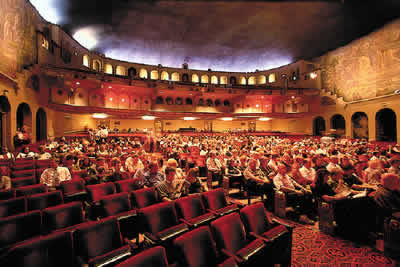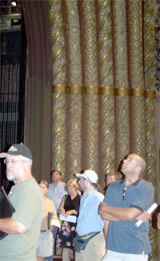 |
 |
 |
|
News & Notices
News From:
Commissions
Conference & Stage Expo
For the Record
 |
The Orpheum Theatre, left, was built in 1929. The Spanish Baroque Revival playhouse reopened in 1997 after a $14 million renovation. Photo/Orpheum
|
|
|
Phoenix Restores Theatre Jewel
Phoenix has a rich artistic and cultural history, and, like many other cities, some of its theatre buildings themselves are as exciting to explore as the companies or productions that inhabit them. One theatre not to be missed while in town for USITT's 2007 Conference & Stage Expo is the Orpheum Theatre, which is within walking distance from the convention center and is a strong example of the Spanish Baroque Revival architecture style. The Orpheum is the last remaining local example of theatre palace architecture and is the only theatre in Phoenix on the National Register of Historic Places. Current plans are to hold the Conference Keynote and Kickoff at the Orpheum. The Orpheum's nearly 80-year history has been filled with ups and downs. The theatre's construction began in 1927 (when downtown Phoenix was a hotbed of new projects) at a cost of $750,000 for J. E. Rickards and Harry Nace. Their dream was to build the most extravagant theatre in Phoenix for vaudeville shows. Vaudeville was beginning to die due to the popularity of motion pictures and needed better, "glitzy" theatres in order to survive. Vaudeville did die, and the Orpheum became mostly a movie house while hosting other events such as local dance recitals. In 1949 the theatre was sold to another movie chain and was renamed the Paramount. Phoenix was booming, but new residents were settling in the suburbs and the advent of television would soon spell the demise of the theatres as the exclusive outlet for entertainment. In 20 short years, the once superior Orpheum was outdated and was no match for suburban theatres built to accommodate Hollywood's latest technologies. By the late 1960s, various owners had obliterated much of the intricate decorative painting that originally graced the Orpheum's lobbies and audience chamber. The murals were painted over in black, to avoid competing for attention with the productions, and four of the graduated "ropes" of decorated plaster that framed the proscenium arch were removed. In 1968, James Nederlander bought the theatre and renamed it Palace West, adding it to his string of playhouses for touring Broadway plays and musical productions. Under his ownership, a new generation of Phoenicians was introduced to the theatre with stage productions such as Cabaret, Barefoot in the Park, Annie, and The Best Little Whorehouse in Texas. Eventually, Nederlander recognized that extensive and expensive improvements would be needed to continue to present first class productions in the building. Instead of doing the renovations, he abandoned the Palace West as a stop for his national touring circuit and leased the theatre to the Corona family, who presented Spanish language films there for several years. During the 1970s, many older buildings in downtown Phoenix were destroyed by fire or were torn down to build high rises. Fortunately, the Orpheum was on the west side of Central Avenue -- in the opposite direction of Phoenix's downtown rebirth. In the early 1980s, Mr. Nederlander decided to put the property on the market rather than renovate it for reuse. At the same time, the Junior League of Phoenix initiated a project to inventory historic buildings in the downtown area, and the Orpheum was identified as a valuable historic property. Then-mayor Terry Goddard and his newly formed historic preservation task force endorsed the idea of having the city buy the theatre to ensure its long-term preservation. Shortly thereafter, the Junior League of Phoenix spearheaded a community effort to retain the architectural and historical integrity of Phoenix's last historic theatre and helped place the Orpheum on the National Register of Historic Places. In the mid-80s, to celebrate the 50th anniversary of the Junior League in Phoenix, the League pledged a $50,000 gift to the City of Phoenix to serve as a catalyst for the theatre's restoration. To raise public support and encourage private sector donations, the League assisted in organizing the Orpheum Theatre Foundation in 1987 and incorporating it in 1989. By adopting the Orpheum Theatre as a project, the League contributed $150,000, 175 volunteers, and thousands of hours over the next 10 years and provided the vision and leadership to realize the completion of the restoration effort. Due to a real estate "downturn" at the end of the '80s, the city's five-year Capital Improvement Program was stretched out to 10 years, and the Orpheum's construction was delayed. In 1990, then-Mayor Paul Johnson and the Phoenix City Council decided to incorporate the Orpheum into the construction plans for the new City Hall, which was to be built on a site on the south half of the Orpheum block. The modern 20-story City Hall building would provide the Orpheum with water, electricity, heating, and cooling. At the same time, the old theatre would be restored to "better than new" so that it could serve as a performing arts center, another step in restarting the heart of the city. Through the leadership of Delbert and Jewell Lewis, president and board chairman of MAC America respectively, the Orpheum Theatre Foundation's Restoration Campaign Committee secured the funds to support a total restoration of the facility before reopening. After $14 million and an incredible amount of perseverance, the historic Orpheum Theatre has been renovated for "adaptive reuse," restoring as much of its visible splendor as possible, while retrofitting it as a modern theatre. Van Dijk, Pace Westlake Architects, was the restoration architect. The Orpheum re-opened on January 28, 1997 with Carol Channing starring in Hello Dolly! The theatre marquee at Second Avenue and Adams Street now, once again, continually announces the names of first class productions drawing several thousand visitors annually to a vibrant downtown venue. Thanks to Mary Montalvo, Venue Manager for the City of Phoenix, for assisting with much of the information for this article. In addition to her work with the Orpheum and other Phoenix stages, Ms. Montalvo also serves as USITT's Engineering Commissioner. |
 Members of the USITT Conference Committee tour the restored Orpheum during an August visit to the facility. Photo/Barbara E.R. Lucas
| |
United States Institute for Theatre Technology, Inc.:
© 2006 Volume XLVI, Number 9